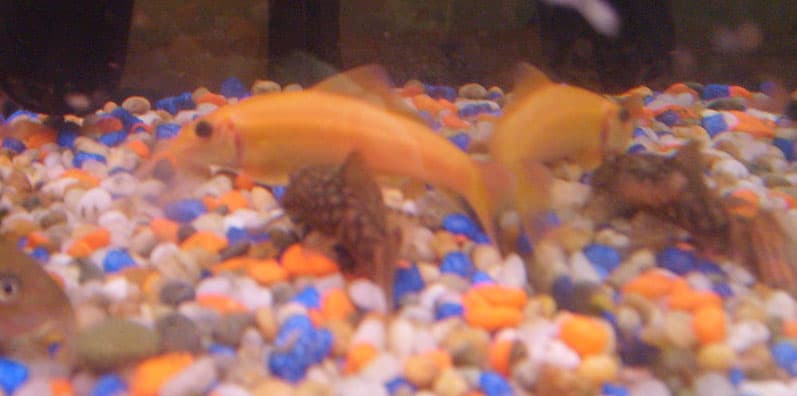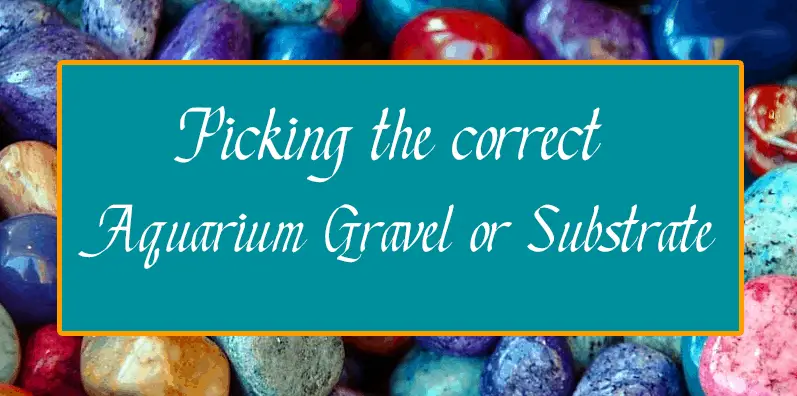Last Updated on January 18, 2021 by cmoarz
What you put on the bottom of your aquarium might seem like a small task, Not something you really give much thought too. But the fact is gravel or any other substrate type proves to be absolutely essential when it comes to the cultivation of beneficial bacteria as well as the overall health of your fish tank.
Given the huge variety of different types of substrate and gravels, It can be very hard to know what your actually supposed to be using in any given tank or set up. There may even be a feeling of being overwhelmed but he sheer volume of choice!
But, Once a proper setup is established you will notice a large reduction in the amount of maintenance required to keep your fish tank healthy and thriving. Trust me when I tell you it’s not as daunting a task as you might expect upon first glance.
With that said, Allow me to walk you threw the basics of what you need to know in order to pick the correct aquarium gravel or substrate for your specific aquarium setup. First thing we should take a look at is the different types of mass available to you.

Aquarium Gravel
Table of Contents
Given the sheer variation when it comes to gravel, be it color, shape, size, grain, roughness, material etc it’s a bit tricky to know exactly what kind you should be getting.
Luckily it is the most commonly used bedding for hobbyist fish keepers so you will find a lot of knowledgeable people who will tell you your should and should nots.
The main thing to consider when picking your gravel is based on what you have living in your tank. Every species of fish or other fish tank creature has it’s own personal preference that will ensure it thrives and prospers.
A good example of a fish you definitely should not add gravel too is the basic goldfish. That’s surprising right? You see so many goldfish tanks with gravel, But unless the gravel is much larger than the goldfishes mouth, it’s wrong!
A gold fish will try and eat literally everything in sight. Your little orange friend is kind of a stupid eating machine more than anything. Where do you think the term “memory of a goldfish” came from?
So, Obviously this is a bad thing. The sharp edges of the gravel can cause all sorts of damage if a fish tries to swallow it, as well as straight up block his throat which can cause stress and death. See how important it is to make sure you are getting the right gravel?

Bottom feeders
Another example of a fish type that doesn’t enjoy or prosper in an aquarium filled with sharp gravel is bottom feeders. This is especially true if they are a filter feeder subspecies who filter substrate for their nutrients.
Of course, there are other types of bottom feeders too, Such as the Kuhli, who will bury himself into the substrate. Aquarium gravel is far too hard and sharp for these types of fish and they will certainly be damaged from the edges.
Large Aquarium Rocks
To continue with the gold fish example, larger rocks would be far more suitable to this sort of fish, that is, assuming you don’t have bottom feeders in the tank as well. If that is the case than you must use a different type of substrate in combination with the large stones.
Alright, So im speaking a lot about the gravel you shouldn’t use in a participle circumstance, So what should i use in those above examples?
Aquarium Sand
Given how a large chunk of the seabed is nothing but sand and silt, You would think more people would consider it in their tanks. But you would be wrong sadly. Truth be told sand is a great option for a lot of aquarium critters.
One of the major benefits to sand is how debris tends to just lay on-top of it rather than falling threw the cracks like it would in gravel. This makes cleaning it a trivial task at best. However their are a few caveats to having this sort of substrate in your tank.
- The size of the sand is important. You should not use very powdery fine sands, rather a a medium or large sized sand is much more preferable. Sand that is too find just turns into mud, which will cloud the tank. This is also detrimental to your tanks inhabitants.
- Don’t compact your sand too much. In fact, if you have sand as a substrate it is almost a requirement to have a bottom feeder species who likes to agitate the sand every once and a while to keep it from become too hard pact.
The various other substrates
There are other types of substrate besides gravel and sand, Here are a few that you might also be interested in using, or should also avoid.

Coral
Coral is very pretty when its alive, and heck, Even when it’s been crushed up for an aquarium. But weather you decide to use coral, Alive or dead, Is entirely dependent on what you have in your tank.
- Coral increases PH level of the water by a considerable amount and is not desirable to most tropical species.
- Coral will harden the water, Again, some fish are OK with this and some AREN’T. Notably it will lower the lifespan of your filter and leave nasty stains on your tank.
- The material is very hard for bottom feeders to deal with
- Coral tends to hold onto dirt and other ickys deep within it’s pores making in impossible to clean well.
With all that said, Coral is good for certain types of fish, notably certain salt water species such as
- Anthias
- Wrasses
- Blennies
- Tangs
Not all salt water species are compatible, even most. Make sure to research the type of fish you have in order to know weather coral is the right choice for your tank. You don’t want to hurt or worst case, accidentally kill your fish!

Substrates for plants
Fish and shellfish aren’t the only things that people tend to overlook initially when setting up their aquarium. In fact, I’m willing to bet most people who go buy a tank for the first time don’t even think of the potential to have living plant life in the tank. Usually they are just thinking about the neat little plastic one on the shelf.
Later on down the road it clicks, “I should get some live plants”, but alas, it would require a great effort to re-do the tank bedding in order to support a living plant. Ick.
So avoid all that and just do it right the first time! (as if right haha).
So what kind of substrate does an aquarium plant require?
You will need a substrate that allows a plant to root properly which will also allow it to gather it’s nutrients and stay healthy. Remember, You must have at least 3 inches of substrate in order for this to happen properly. Any less could cause stability issues in the plant as well as poor rooting.
Plant substrate is usually a specific type of substrate designed specifically for plants in aquariums. It’s usually comprised of certain types of rocks, and clay and even ground up shells of other aquarium species. Pretty brutal stuff, But if the plants like it who’s to argue?
Having no substrate at all
This is of course always an option that people can opt for. Not using any substrate at all can make cleaning a bit easier, However, If you don’t have something else in the tank that will help cultivate beneficial-bacterial it could ultimately be bad for the tank.
Really anything porous will do, Such as a wood decoration, or fake rocks and plants. While not perfect, in most cases it should help keep ammonia levels down.
Overall this is not an ideal choice and I personally don’t recommend it outside of very specific purposes.
How much gravel should I be using in my aquarium?
A tank of around 55 gallons having a measurement of around 49 inches by 12 inches would require roughly around 30 pounds of gravel for a bed that is of around one inch. Once this has been worked out, the rest becomes easy. You have to just multiply the depth making use of inches. To put it simply, for a two inch bed you would require 60 pounds of gravel.
https://aquariumgravel.com/aquarium-gravel-and-alternatives/why-should-i-use-aquarium-gravel-in-my-tank/
About
Owner of AquariumGravel.com and also owner of actual Aquarium Gravel believe it or not! ;). Setting up beautiful aquarium sceneries and habitats since I was very young. Enjoy!
- Web |
- More Posts(290)

